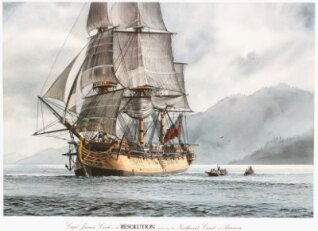About a year ago I was standing on the rocky bluff above Victoria Golf Course looking out at Trial Island, Juan de Fuca Strait and the Olympic Mountains. It is a scene that always grabs me, slowing me down long enough to appreciate this lovely corner of the world we call home.
On this occasion it went a bit further. Running through the panorama, I watched a steady procession of boats and ships passing by: motor and sail yachts, cruise ships, tankers and freighters, whale watching and fish boats, military ships and patrol vessels. No matter the type, size or speed of the boat, it occurred to me that once the wake dissipated into the sea, all physical record of the boat having been there was gone forever. Yes, there was a record on a logbook somewhere, I suppose, but the thought struck me how the earliest ships to travel these waters left behind a much longer lasting legacy. The earliest ships and the men that sailed them left their mark on history, shaping what was to take place long after they navigated these waters.
Here are five ships that sailed our coastline in different times and left their mark, in varying degrees, on British Columbia’s history.
Please note that the first two ships, HMS Resolution under Captain James Cook and HMS Discovery under Captain George Vancouver, were enormously long adventures in time and distance so please forgive us if we truncate their journeys to local waters.
***
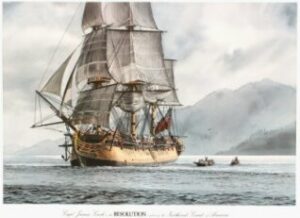
HMS Resolution
HMS Resolution was a merchant collier bought by the Royal Navy and converted for Captain James Cook’s second (1772-75) and third (1776-80) voyages of exploration in the Pacific. Cook’s support vessel for the voyage was the smaller Discovery, not to be confused with HMS Discovery, Captain George Vancouver’s ship.
It was Cook’s third voyage that took him to the mouth of Juan de Fuca Strait and north to Nootka Sound where he influenced what was to be B.C. history.
Specifications
Tonnage 462 tons
Length 33.73 m (110’ 8”) overall; 28.5 m (93’ 6”) keel
Beam 9.30 m (30’ 6”)
Draft 3.99 m (13’1”)
Complement 112 including 20 marines
Armament 12 x six-pounders; 12 x 1.5-pounder swivel guns
Equipment Gregory Azimuth Compass, ice anchors, apparatus for distilling fresh water from seawater
Cost £4,151 (refit: £10,080)
Legacy
The purpose of Cook’s third voyage was to discover the illusive Northwest Passage to connect the Atlantic and Pacific oceans around North America. See: cookmuseumwhitby.co.uk for full details.
On his journey north along the West Coast, Cook passed the entrance to Juan de Fuca Strait and sailed the Vancouver Island coast to Nootka Sound where he anchored near Yuquot (Friendly Cove), a Nuu-chah-nulth village, in 1778.
During his visit, it appears Captain Cook and crew got a lesson in trading from the locals who wanted metal items in trade for everything. The most valuable items the British took away, almost unwittingly, were sea otter pelts. The pelts brought such high prices in China that they touched off a major trade network that attracted fur traders from around the world to the north Pacific Ocean.
After leaving Nootka Sound, Cook explored and mapped the B.C. and Alaska coast to the Bering Strait. His charts covered the majority of the North American northwest coastline and opened the way for future exploration.
Resolution went on to complete the journey home without Cook as he was killed in Hawaii in 1779.
***
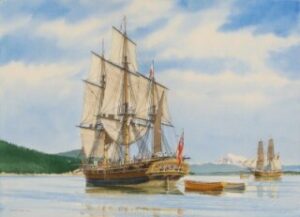
HMS Discovery
This HMS Discovery was designed and built in 1789 and bought by the Royal Navy. She was a full-rigged ship with a crew of 100, originally built to explore the southern whaling fisheries, but the 1789 Nootka Crisis changed the plans. Captain Vancouver was given command of Discovery and directed to assist with the Nootka Sound Conventions, survey the Sandwich (Hawaiian) Islands, and chart the West Coast from 30° and 60°N to confirm if the Northwest Passage existed. Accompanied by the small, armed tender Chatham (131 tons), Discovery sailed for the Pacific on April 1, 1791 and arrived on the California coast north of San Francisco a year later.
Specifications
Tonnage 337 tons
Length 30.23 m (99’ 2”) overall; 23.67 m (77’ 8”) keel
Beam 8.617 m (28’ 3”)
Depth of hold 3.76 m (12’ 4”)
Complement 94 to 100
Armament 10 x four-pounders; 10 x ½ pounder swivel guns
Legacy
While Vancouver’s expedition took four years to complete, it was the year 1792 when he left his mark upon the region. Having surveyed and charted the Oregon and Washington shores, including explorations of Puget Sound via small boats, Vancouver headed Discovery and Chatham north. Here he wrote history with names like Vancouver Island, Discovery and Chatham islands, Howe Sound, False Creek, English Bay and Spanish Banks, where he met two Spanish schooners Sutil and Mexicana. Vancouver’s amazingly accurate charts also marked popular boating destinations like Savary Island, Desolation Sound and Discovery Passage, and landmarks like Mount Baker, Mount St. Helens and Mount Hood.
***
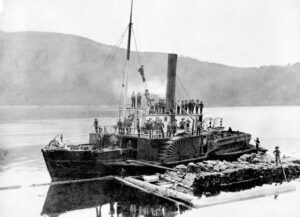
SS Beaver
If ships coule be local heroes, the sidewheeler Beaver would be one. Built in Blackwall, England, she was launched May 9, 1835, and sailed from London with the Hudson’s Bay Company barque Columbia. Sailing as a brigantine, Beaver made passage to the Columbia River around Cape Horn; her paddlewheels were stowed for the voyage. On April 10, 1836, Beaver arrived at Fort Vancouver where her paddlewheels were installed and boilers and engines started up, making her the northwest’s first steamship.
Specifications
Tonnage 190 tons
Length 31 m (101’)
Power Twin 35 horsepower steam engines
Complement 26
Legacy
From the Columbia River to Alaska, Beaver served as a floating trading post for the Hudson’s Bay Company under James Douglas and his men. When the Oregon Treaty was signed in 1846, which moved the boundary to the 49th parallel, Beaver’s homeport had changed to Fort Victoria. When she was replaced with the propeller driven Otter, she became a transport ship moving cargo and passengers between the Colony of Vancouver Island and the Colony of British Columbia (formerly New Caledonia). She played an important role in helping maintain British control during the Fraser Canyon Gold Rush (1858-59) with its massive influx of mostly American gold miners. She next served the Royal Navy under Lt. Daniel Pender to chart the B.C. coast. In 1874 she was sold to the British Columbia Towing and Transportation Company and towed barges, log booms and sailing vessels until she ran aground near Prospect Point in Vancouver’s Stanley Park 14 years later, ending 52 years of service that made her one of B.C.’s most famous ships.
***
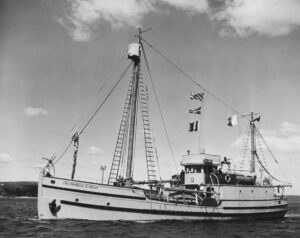
St. Roch
Built by Burrard Drydock in North Vancouver for the Royal Canadian Mounted Police to patrol the Arctic, serve as a RCMP supply ship and as a detachment when frozen into the winter ice, St. Roch was launched on May 7, 1928 to begin her long career of amazing exploits that included being the first ship to circumnavigate North America.
Specifications
Tonnage 197 tons
Length 31.8 m (104’3”)
Beam 7.5 m (24’7”)
Draft 3.25 m (10’8”)
Hull Douglas fir with Australian gumwood outer hull; rounded hull to allow ice to slide underneath; steel plate covering bow
Power six-cylinder, 150 hp Union diesel
Complement eight
Legacy
St. Roch was built in British Columbia and resides in Vancouver today, yet her history is fully Canadian in scope. St. Roch takes her name from the Quebec east riding of Ernest Lapointe, the Federal Minister of Justice in charge of the RCMP when she was launched. From 1940 to 1942, with Sergeant Henry Larsen as skipper, a position he held for 20 years, St. Roch became the second ship to travel from west to east across the Northwest Passage. In 1944, she became the first ship to travel from east to west taking only 86 days to complete the alternate northerly route. During the Second World War, it was important for Canada to show sovereignty over the Arctic and northern territories. St. Roch was retired three years later and made the trip through the Panama Canal to Halifax in 1950 thus making her the first ship to circumnavigate North America. St. Roch was moved to the Vancouver Maritime Museum where she was restored to her 1944 appearance, complete with sled dogs on the deck. Declared a National Historic Site, she rests on Kitsilano Point, a worthy location for a Canadian icon.
***
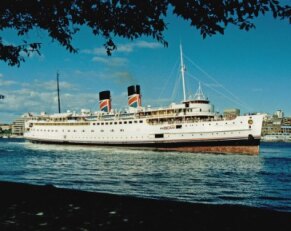
Princess Marguerite and Princess Patricia
These sister ships were built by Glasgow’s Fairfield Company for the B.C. Coast Service of the Canadian Pacific and arrived to Victoria within two months of each other in 1949. They were designed and built to serve on the Seattle-Victoria-Vancouver international triangle run and could host 2,000 passengers. While they had limited stateroom accommodations, the ships’ traditional finish and expansive public spaces had the look and feel of smaller classic ocean liners. Princess Patricia won the heart of this writer at the age of 10 when my father took me from Victoria to Vancouver on the overnight sailing.
Specifications
Length 112.5 m (369’)
Tonnage 5,611 tons
Beam 17.07 m (56’)
Draft 4.88 m (16’)
Power Four oil-fired water tube boilers provided steam at 320 pounds pressure to twin-screw steam turbo-electric drives.
Cost $4,000,000 each
Legacy
Whether it was Princess Marguerite or Princess Patricia arriving at Victoria’s Inner Harbour, their triple-bell Steven and Struthers steam whistles got everybody’s attention. The twin-funnel (painted with Union Jacks) turbine steamships’ classic looks added greatly to the “Jolly Olde England” theme that has played a large role in developing Victoria’s successful tourism industry.
Over the 30-plus years of service, the Princesses proved to be international tourist attractions in their own right. So much so, Princess Marguerite was made an Honorary Distinguished Citizen of the State of Washington and an Honorary Citizen of Seattle.
Whether it was Maggie or Pattie, as we teenagers called them, sailing by Victoria’s Oak Bay, we probably gave their passengers a little added entertainment by flying our fathers’ runabouts over the ships’ wakes as they passed Discovery and Chatham islands. To us, the Princesses were friendly neighbours in the grand backyard we young boaters called home.
Princess Patricia was retired from cruise service in 1978 and served as a hotel ship during Expo 86 before being scrapped in 1995. Princess Marguerite’s last Seattle-Victoria run was September 17, 1989. She was scrapped eight years later.
***
[SIDEBAR] Steve Mayo, Marine ArtistSteve Mayo’s interest in Pacific Northwest 18th century voyages of exploration started as a young man sailing on the Columbia River. There he developed a fascination with ships and all things related to maritime history.
He studied fine arts at college and the San Francisco Art Museum and began his art career while working on tugboats. In 1975, Mayo left the industry to pursue art full-time. He used his own 60-foot classic tugboat Skua to research historic northwest locations to ensure the accuracy of his paintings.
Having earned his professional captain’s license, he skippered the 75-foot oil recovery vessel, Western Gull, for 20 years while continuing to paint historic maritime watercolours. His artwork is on display at the Kirsten Gallery in Seattle, Washington, and at stevemayoart.com.
Today Mayo and his wife live in Bellingham, Washington where he paints in his studio overlooking Bellingham Bay.
